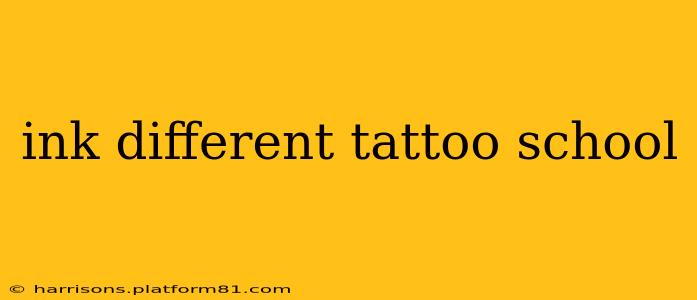Ink Different: Exploring the Diverse World of Tattoo Schools
The world of tattooing is a vibrant tapestry woven from diverse styles, techniques, and philosophies. Understanding these differences is key to appreciating the art form and choosing the right artist for your next piece. This exploration delves into the various "schools" or styles of tattooing, highlighting their unique characteristics and historical influences.
What are the Different Tattoo Styles? (A Common Question)
This isn't a question with a definitive number of answers, as new styles constantly emerge and evolve through the fusion of existing ones. However, some prominent and recognizable schools of tattooing consistently stand out. We'll explore several key styles below.
Traditional American
This style, often referred to as "Old School," is characterized by its bold outlines, solid black shading, and limited color palettes typically featuring primary colors. Images are often straightforward and symbolic, drawing inspiration from nautical themes, pin-ups, eagles, and other classic American imagery. The clean lines and simplicity are designed for longevity, ensuring the tattoo remains visually appealing even as it ages.
Japanese
Japanese tattooing, or irezumi, is arguably one of the most recognizable and respected tattoo styles globally. It's a rich tradition with a profound history, featuring intricate designs, bold lines, and vibrant colors. Common motifs include mythical creatures like dragons and koi fish, alongside floral patterns and scenes from Japanese folklore. Japanese tattooing often involves large-scale pieces that tell a story or convey a specific meaning.
Neo-Traditional
As its name suggests, Neo-Traditional tattooing builds upon the foundations of Traditional American but adds a modern twist. It retains the bold outlines and solid colors, but incorporates more complex shading, a wider range of color palettes, and more dynamic compositions. Artists often experiment with perspective and add details not found in its predecessor, resulting in a vibrant and contemporary take on the classic style.
Realism
Realism in tattooing aims to achieve photorealistic depictions of subjects, whether portraits, landscapes, or other detailed imagery. This style demands exceptional skill and precision from the artist, requiring a deep understanding of shading, color blending, and skin tone to create lifelike results. Realism often involves extensive sessions and meticulous attention to detail.
Watercolor
Watercolor tattoos mimic the look and feel of traditional watercolor paintings. They’re characterized by their soft, flowing lines, blended colors, and lack of hard outlines. This style creates a dreamy, ethereal effect, making it a popular choice for those seeking a more artistic and less defined look.
Geometric
Geometric tattoos utilize sharp lines, angles, and shapes to create intricate and often abstract designs. They often incorporate mandalas, sacred geometry, and other patterns with symbolic meaning. The precision and clean lines required make this style a testament to the artist’s skill.
What are the Pros and Cons of Different Tattoo Styles?
The "pros" and "cons" of each tattoo style are largely subjective and depend on individual preferences. However, some general observations can be made:
- Traditional American: Pros – timeless, bold, and easy to read; Cons – limited color palette, simpler designs.
- Japanese: Pros – rich cultural history, visually stunning; Cons – often large-scale and requires commitment.
- Neo-Traditional: Pros – blends classic and modern elements; Cons – can be more expensive due to complexity.
- Realism: Pros – incredibly lifelike results; Cons – lengthy sessions, high cost, and requires an expert artist.
- Watercolor: Pros – dreamy and artistic; Cons – can fade more quickly than other styles.
- Geometric: Pros – precise and visually striking; Cons – may not be suitable for all body placements.
How Do I Choose the Right Tattoo Style for Me?
Choosing the right tattoo style is a deeply personal journey. Consider the following:
- Your personal style and preferences: What kind of art do you enjoy? What kind of aesthetic are you drawn to?
- The message or meaning you want to convey: Different styles lend themselves to different meanings and symbolism.
- The artist's skill and experience: Find an artist who excels in the style you’ve chosen.
- The placement and size of your tattoo: Some styles are better suited for certain body locations and sizes.
Ultimately, the best tattoo style for you is the one that resonates most deeply with you and reflects your individual expression. Take your time, do your research, and find an artist you trust to bring your vision to life.
